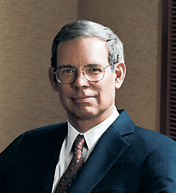It’s not always easy being green.
When Tiffany & Co. stopped using coral in its jewelry in 2002—and encouraged the rest of the jewelry industry to follow in its footsteps—the company faced serious backlash.
“We simply decided that we could not be complicit in the destruction in coral reefs around the world,” said Michael Kowalski, W’74, the luxury jewelry company’s chairman and CEO. “We were threatened. We received death threats. We had a number of protests at some of our stores around the world.”
But, he said, the long-term benefits far outweighed any financial gain from selling products featuring coral. The company took its focus on preserving the natural resource further; over the course of two weeks, Tiffany stores around the globe featured windows that focused on the dangers coral jewelry poses to coral reefs. The Tiffany Foundation contributed funds to coral conservation. Representatives testified before Congress to help educate consumers about marine conservation.

Michael Kowalski, W’74. Photo Credit: Martyn Thompson.
Then, Kowalski and his colleagues came to an interesting realization: “We learned, and it was a surprise to us, … that the Tiffany brand—and all luxury brands—really do have the power to get people’s attention when you talk about something unexpected.”
Kowalski, who is chairman of the Board of Overseers of the University of Pennsylvania’s Museum of Archaeology & Anthropology, discussed the brand’s commitment to sustainability and corporate responsibility during the fundraising event “Treasures: Jewelry Sale & Show,” which took place in October .
He acknowledged that most don’t look to a luxury brands like Tiffany as a bastion of social responsibility.
“Some suspect we are green-washing,” he noted. “But at our core, we are designers and we are craftsman. … There are few things that inspire us more than the natural world. It’s in keeping with our brand vision that we want to help sustain the natural beauty that inspires us.”
Beyond the company’s work with coral conservation, Kowalski discussed Tiffany’s commitment to responsible mining practices, protection of precious ecosystems, and increased transparency in the diamond mining industry. The company advocates environmentally and socially sound sourcing practices and encourages others in the jewelry industry to follow suit; however, he notes, efforts are still relatively new. Sustainability has only been an issue addressed by the industry for the past 15 years.
He said that the key to successful corporate responsibility practices is to focus not only on the problems, but the solutions that can drive social value and economic good.
“Sustainability is also about improving economic opportunity, particularly for people in impoverished areas,” Kowalski said.
He points to Tiffany’s continued efforts working with diamond mines in Africa. While the company could have chosen to withdraw its business from the continent after the infamous blood diamond stories began to surface in the 1990s, the corporation sought to turn tragedy into opportunity and avoid hurting countries’ diamond-dependent economies. The company has invested in responsible mining, increased oversight and transparency, and funded infrastructure in these countries.
Kowalski said he hopes that Tiffany sets a new industry standard for corporate responsibility.
“We can have a great positive influence, and we’re trying to use the power of the Tiffany brand to influence others in the jewelry industry,” he emphasized.

























